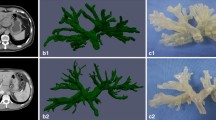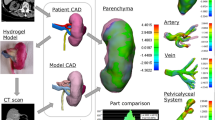Abstract
Objectives
To explore a method to create affordable anatomical models of the biliary tree that are adequate for training laparoscopic cholecystectomy with an in-house built simulator.
Methods
We used a fused deposition modeling 3D printer to create molds of Acrylonitrile Butadiene Styrene (ABS) from Digital Imaging and Communication on Medicine (DICOM) images, and the molds were filled with silicone rubber. Thirteen surgeons with 4–5-year experience in the procedure evaluated the molds using a low-cost in-house built simulator utilizing a 5-point Likert-type scale.
Results
Molds produced through this method had a consistent anatomical appearance and overall realism that evaluators agreed or definitely agreed (4.5/5). Evaluators agreed on recommending the mold for resident surgical training.
Conclusions
3D-printed molds created through this method can be applied to create affordable high-quality educational anatomical models of the biliary tree for training laparoscopic cholecystectomy.





Similar content being viewed by others
References
Agresta F, Campanile FC, Vettoretto N, Silecchia G, Bergamini C, Maida P, Esposito MG (2015) Laparoscopic cholecystectomy: consensus conference-based guidelines. Langenbeck’s Arch Surg 400(4):429–453
Badash I, Burtt K, Solorzano CA, Carey JN (2016) Innovations in surgery simulation: a review of past, current and future techniques. Ann Transl Med 4(23):453
Bücking TM, Hill ER, Robertson JL, Maneas E, Plumb AA, Nikitichev DI (2017) From medical imaging data to 3D printed anatomical models. PLoS ONE 12(5):e0178540
Cheung CL, Looi T, Lendvay TS, Drake JM, Farhat WA (2014) Use of 3-dimensional printing technology and silicone modeling in surgical simulation: development and face validation in pediatric laparoscopic pyeloplasty. J Surg Educ 71(5):762–767
Daemen JH, Heuts S, Olsthoorn JR, Maessen JG, Sardari Nia P (2019) Mitral valve modelling and three-dimensional printing for planning and simulation of mitral valve repair. Eur J Cardiothorac Surg 55(3):543–551
Hasan OH, Ayaz A, Khan M, Docherty C, Hashmi P (2019) The need for simulation in surgical education in developing countries. The wind of change. Review article. J Pak Med Assoc 69(Supl. 1):62
He Y, Xue GH, Fu JZ (2014) Fabrication of low cost soft tissue prostheses with the desktop 3D printer. Sci Rep 4(1):1–7
Hyodo T, Kumano S, Kushihata F, Okada M, Hirata M, Tsuda T, Murakami T (2012) CT and MR cholangiography: advantages and pitfalls in perioperative evaluation of biliary tree. Br J Radiol 85(1015):887–896
Isaranuwatchai W, Brydges R, Carnahan H, Backstein D, Dubrowski A (2014) Comparing the cost-effectiveness of simulation modalities: a case study of peripheral intravenous catheterization training. Adv Health Sci Educ 19(2):219–232
Kim GB, Lee S, Kim H, Yang DH, Kim YH, Kyung YS, Kwon SU (2016) Three-dimensional printing: basic principles and applications in medicine and radiology. Korean J Radiol 17(2):182–197
Lee S, Ahn JY, Han M, Lee GH, Na HK, Jung KW, Jung HY (2018) Efficacy of a three-dimensional-printed training simulator for endoscopic biopsy in the stomach. Gut Liver 12(2):149
Mitsouras D, Liacouras P, Imanzadeh A, Giannopoulos AA, Cai T, Kumamaru KK, Ho VB (2015) Medical 3D printing for the radiologist. Radiographics 35(7):1965–1988
Premyodhin N, Mandair D, Ferng AS, Leach TS, Palsma RP, Albanna MZ, Khalpey ZI (2018) 3D printed mitral valve models: affordable simulation for robotic mitral valve repair. Interactive Cardiovasc Thorac Surg 26(1):71–76
Rivas AM, Vilanova AC, Pereferrer FS, González MH, del Castillo DD (2010) Simulador de bajo coste para el entrenamiento de habilidades laparoscópicas básicas. Cirugía Española 87(1):26–32
Rocha JA, Cárdenas-Lailson LE, Beristain-Hernández JL (2011) Variantes anatómicas de la vía biliar por colangiografía endoscópica. Revista de Gastroenterología de México 76(4):330–338
Sarawagi R, Sundar S, Gupta SK, Raghuwanshi S (2016) Anatomical variations of cystic ducts in magnetic resonance cholangiopancreatography and clinical implications. Radiol Res Pract Vii:1–6. https://doi.org/10.1155/2016/3021484
Tolino MJ, Tartaglione AS, Sturletti CD, García MI (2010) Variedades anatómicas del árbol biliar: Implicancia quirúrgica. Int J Morphol 28(4):1235–1240
Troncoso-Bacelis A, Soto-Amaro J, Ramírez-Velázquez C (2017) Calentamiento en endotrainer previo a colecistectomía laparoscópica. Cirugía y Cirujanos 85(4):299–305
Vassiliou MC, Ghitulescu GA, Feldman LS, Stanbridge D, Leffondre K, Sigman HH, Fried GM (2006) The MISTELS program to measure technical skill in laparoscopic surgery. Surg Endosc Other Intervent Tech 20(5):744–747
Yam BL, Siegelman ES (2014) MR imaging of the biliary system. Radiol Clin 52(4):725–755
Nagassa RG, McMenamin PG, Adams JW, Quayle MR, Rosenfeld JV (2019) Advanced 3D printed model of middle cerebral artery aneurysms for neurosurgery simulation. 3D Print Med 5(1):11
Acknowledgements
The study was supported by the 3D laboratory and its members of the Radiological department of the Hospital Universitario “Jose Eleuterio Gonzalez” in Monterrey, Nuevo León.
Author information
Authors and Affiliations
Contributions
CCM: project development, data collection, manuscript writing, and data analysis. AZR: project development, data collection, and manuscript writing. RELB: project development, data collection, and manuscript writing. ASU: project development, data collection, and manuscript writing. AGH: project development, data collection, and manuscript writing. GEMM: project development, data collection, and manuscript writing. MSC: project development, data collection, and manuscript writing. GER: project development, data collection, and manuscript writing. AANO: project development, data collection, manuscript writing, and data analysis.
Corresponding author
Ethics declarations
Conflict of interest
No potential conflict of interest relevant to this article.
Additional information
Publisher's Note
Springer Nature remains neutral with regard to jurisdictional claims in published maps and institutional affiliations.
Rights and permissions
About this article
Cite this article
Casas-Murillo, C., Zuñiga-Ruiz, A., Lopez-Barron, R.E. et al. 3D-printed anatomical models of the cystic duct and its variants, a low-cost solution for an in-house built simulator for laparoscopic surgery training. Surg Radiol Anat 43, 537–544 (2021). https://doi.org/10.1007/s00276-020-02631-3
Received:
Accepted:
Published:
Issue Date:
DOI: https://doi.org/10.1007/s00276-020-02631-3




